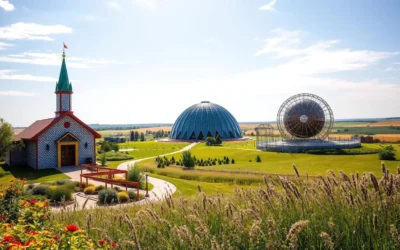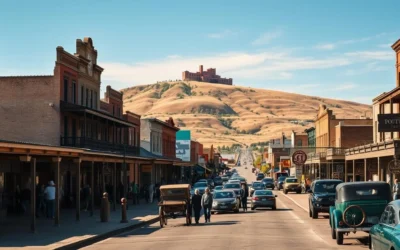✓ Accommodations✓ Flights✓ Rental Cars✓ Tours & Activities
Planning a trip to Kansas requires more than just picking a destination; it demands understanding the state’s notoriously variable weather. With significant changes in temperature and precipitation throughout the year, timing is crucial for a comfortable and enjoyable trip.
The state’s continental climate means you can experience radical day-to-day temperature changes. From the strong wind gusts to dramatic sunsets, Kansas’s weather is a defining characteristic of the regional personality.
Understanding the best months to visit based on your preferences for temperature, precipitation, and outdoor adventures can make all the difference. Whether you’re looking for a relaxing getaway or an action-packed journey, Kansas has something to offer in every season.
Understanding Kansas Climate: Four Distinct Seasons
As you plan your trip to Kansas, understanding the state’s climate is crucial, given its four distinct seasons and varied weather conditions across the state. Kansas’ climate is influenced by its location in the Midwestern United States, with a mix of continental and regional weather patterns.
Continental Climate Characteristics
Kansas has a continental climate with cold winters and hot summers. The state’s climate is characterized by significant temperature variations throughout the year. The weather in Kansas can be quite different depending on the place you are visiting.
Regional Weather Variations Across the State
Regional weather variations are significant in Kansas. You’ll notice differences in weather conditions between the eastern and western parts of the state. Some key regional variations include:
- The western region is typically drier and experiences more extreme temperature variations.
- Eastern Kansas is more humid with higher rainfall amounts.
- Northern Kansas generally experiences colder winters with more snowfall.
- The Flint Hills region has its own microclimate due to its unique topography.
Spring in Kansas: March Through May
Spring breathes new life into Kansas, making March through May an ideal time to visit. The season brings a refreshing change to the state’s landscape and climate.
Temperature and Precipitation Patterns
During spring, Kansas experiences mild temperatures, with averages ranging from 50°F to 70°F. Precipitation patterns become more consistent, with rainfall contributing to the state’s lush vegetation.
Blooming Landscapes and Natural Beauty
As spring progresses, Kansas’s landscapes transform with blooming flowers and greenery. The state’s parks and natural areas become particularly picturesque, making it a great time for outdoor activities.
Spring Activities and Events
Spring in Kansas is filled with various activities and events. You can participate in numerous spring festivals, explore the state’s extensive trail systems, and visit local farmers’ markets. Some notable events include the Symphony in the Flint Hills and First Friday art gallery tours.
| Activity/Event | Description | Location |
|---|---|---|
| Spring Festivals | Celebrate renewal with tulip festivals and outdoor art shows | Various locations across Kansas |
| Hiking and Biking | Explore Kansas’s extensive trail systems | State parks and natural areas |
| Symphony in the Flint Hills | Combine music with nature in the prairie landscapes | Flint Hills region |
Summer in Kansas: June Through August
From June to August, Kansas experiences its warmest season, filled with festivals and outdoor recreation. The state’s climate during this period is characterized by hot and humid weather, making it ideal for a variety of summer activities.
Hot and Humid Weather Conditions
Summer in Kansas brings hot temperatures and high humidity, typical of the continental climate. Daytime temperatures often soar, while nighttime temperatures can remain warm.
Summer Outdoor Recreation Opportunities
You can enjoy numerous outdoor activities during Kansas summers, such as hiking, fishing, and boating. The state’s many parks and lakes provide ample opportunities for outdoor recreation.
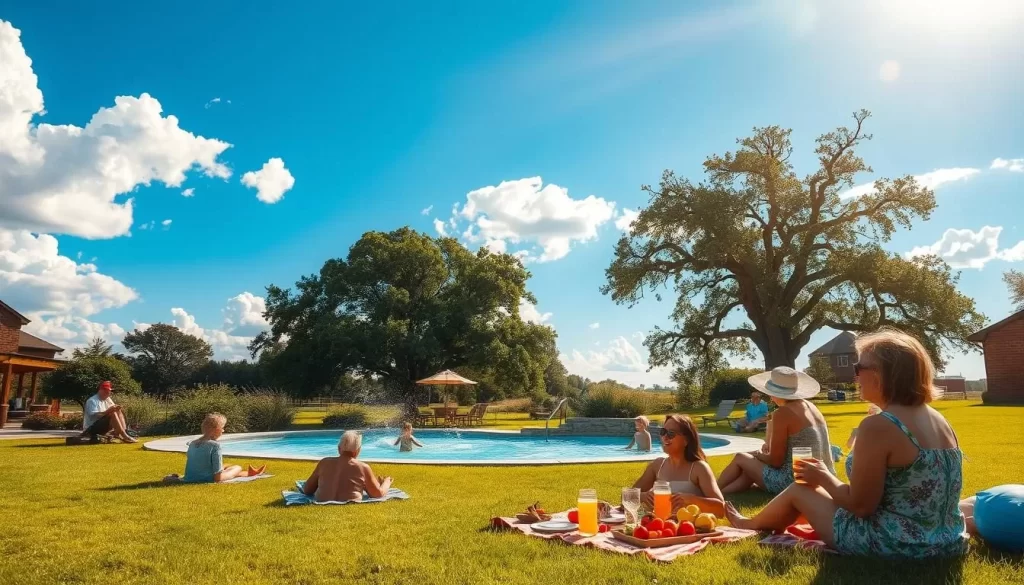
Festivals and Events During Summer Months
Summer is a peak season for events in Kansas, with many family-friendly festivals taking place across the state. You can attend outdoor concerts, cultural celebrations, and food festivals that showcase the state’s rich heritage.
Fall in Kansas: September Through November
Experience the best of Kansas in the fall, with comfortable temperatures and a wide range of activities and attractions. The season brings a picturesque landscape with changing foliage, making it an ideal time to explore the state’s natural beauty.
Moderate Temperatures and Changing Foliage
During the fall season, Kansas enjoys moderate temperatures, creating a pleasant atmosphere for outdoor exploration. The changing foliage adds a kaleidoscope of colors to the landscape, making it perfect for scenic drives and nature walks.
Harvest Season Activities
Fall in Kansas is synonymous with harvest season, offering a variety of events and activities. You can indulge in pumpkin decorating, hayrides, and exploring corn mazes at places like Shuck’s Corn Maze and Pumpkin Patch. The Great Pumpkin Fest at Worlds of Fun is another highlight, providing fun-filled experiences for the whole family.
Fall Festivals and Sporting Events
Kansas hosts numerous fall festivals, including Oktoberfest celebrations that honor the state’s German heritage. For sports enthusiasts, the fall season brings exciting opportunities to catch Kansas City Chiefs football games, as well as college football matches at Kansas State University and the University of Kansas. You can also experience unique Kansas traditions like “burning the prairie” at controlled burns.
- Attend various fall festivals across Kansas, celebrating the season with themed activities.
- Enjoy football season with opportunities to attend college games at Kansas State University and the University of Kansas.
- Participate in Oktoberfest celebrations honoring Kansas’s German heritage.
- Explore Halloween-themed events, including family-friendly pumpkin festivals and haunted attractions.
Winter in Kansas: December Through February
Winter in Kansas, spanning from December to February, brings a unique blend of cold weather, holiday cheer, and seasonal activities for all ages. The state’s winter landscape offers a serene backdrop for various events and celebrations.
Temperature Ranges and Snowfall Expectations
Kansas winters are characterized by cold temperatures, with average lows ranging from 14°F to 24°F (-10°C to -4°C). Snowfall varies across the state, with some areas receiving heavier snow than others. Understanding these conditions helps in planning your winter trip.
Indoor Attractions and Winter Activities
During the winter season, Kansas offers numerous indoor attractions and activities suitable for family outings. One highlight is the Crown Center Ice Terrace in Kansas City, where you can enjoy ice skating with a panoramic view of the city. Additionally, many museums and cultural institutions remain open, providing a warm respite from the cold.
Holiday Celebrations and Events
Kansas is festive during the winter holidays, with various events and celebrations. The Mayor’s Christmas Tree at Crown Center is a must-see, adorned with thousands of sparkling lights. You can also experience festive holiday light displays, special holiday performances, and winter festivals featuring ice sculptures and seasonal activities for the whole family.
| Winter Activity | Location | Description |
|---|---|---|
| Ice Skating | Crown Center Ice Terrace, Kansas City | Outdoor ice skating with a city view |
| Holiday Light Displays | Various locations across Kansas | Festive light displays, including drive-through exhibitions |
| Christmas Tree Lighting | Crown Center, Kansas City | Illumination of the Mayor’s Christmas Tree |
Kansas, United States: Best Months for a Weather-Savvy Trip
Understanding Kansas’ weather patterns is key to planning a successful and enjoyable trip. The state’s climate varies significantly throughout the year, making some months more suitable for visiting than others.
April and May: Ideal Spring Visiting Months
Spring is a beautiful time in Kansas, with mild temperatures and blooming landscapes. April and May are particularly pleasant, with comfortable temperatures and fewer crowds, making them ideal for outdoor activities.
September and October: Perfect Fall Exploration
Fall is another excellent season to visit Kansas. September and October offer moderate temperatures and vibrant foliage, creating a picturesque backdrop for exploring the state’s natural beauty and outdoor attractions.
Weather Considerations for Summer and Winter Visits
If you’re planning to visit during the summer or winter, be aware of the extreme weather conditions. Summers can be hot and humid, while winters are cold and sometimes snowy. However, with proper planning, you can still enjoy Kansas during these seasons. For example, summer is perfect for water-based recreation, while winter offers holiday celebrations and indoor cultural experiences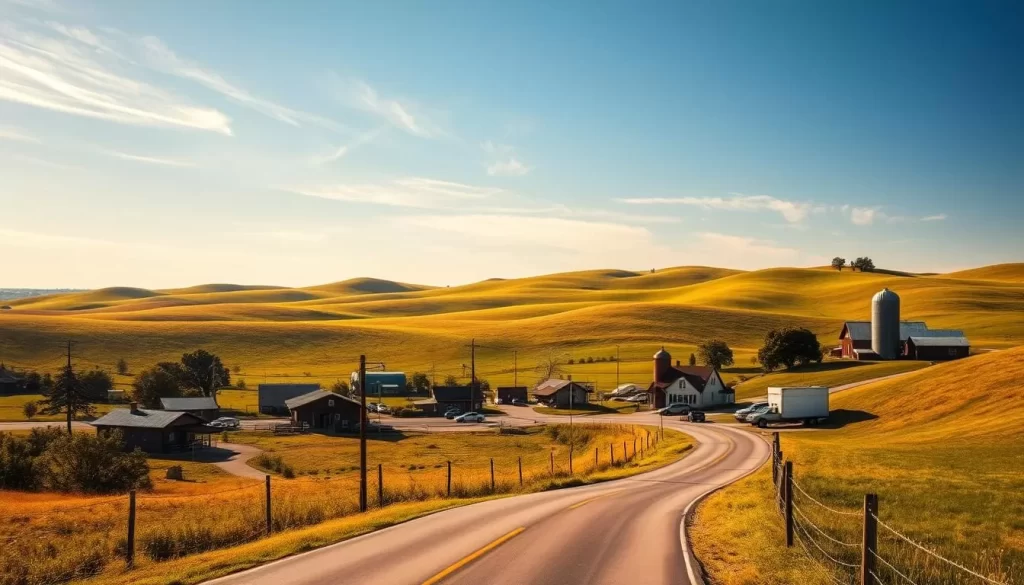
Eastern Kansas Weather Patterns
As you plan your visit to Eastern Kansas, you’ll want to consider the area’s weather patterns to make the most of your trip. The region’s climate is characterized by distinct seasonal changes, with each season offering unique experiences and activities.
Kansas City and Surrounding Areas
Kansas City and its surrounding areas experience a mix of weather conditions throughout the year. In the spring, the area comes alive with blooming landscapes and moderate temperatures, making it an ideal time for outdoor activities.
- Late April through early June offers excellent weather for visiting, with comfortable temperatures and blooming landscapes.
- Summer visits can be hot and humid, making early morning activities preferable.
Best Times to Visit Eastern Kansas
The best months to visit Eastern Kansas depend on your preferences. For those who enjoy outdoor activities and festivals, summer is a prime time. For a more leisurely experience, September and October provide pleasant temperatures and stunning fall foliage.
- You’ll find that September and October feature pleasant temperatures and fall color displays, particularly in wooded areas.
- Early spring and late fall offer moderate temperatures and comfortable conditions for exploring outdoor attractions.
Central Kansas Climate Considerations
Central Kansas, with Wichita at its heart, offers a unique blend of weather patterns that are worth understanding for a well-planned trip. The region experiences a continental climate with significant variations across seasons, making some times of the year more suitable for visits than others.
Wichita and the Heart of Kansas
Wichita, being the largest city in Central Kansas, exemplifies the region’s climate. You’ll find that the weather here is characterized by hot summers and cold winters, with spring and fall being the most pleasant seasons. These transitional periods offer mild temperatures and fewer extreme weather events, making them ideal for outdoor activities and sightseeing.
Optimal Months for Central Kansas Exploration
The best months to visit Central Kansas are April, May, September, and October. During these months, the weather is generally mild and conducive to outdoor exploration. May and early June are particularly pleasant, with green landscapes, while September and early October offer the harvest season’s charm. You’ll find that these periods provide excellent opportunities for enjoying the natural beauty and activities the region has to offer.
| Month | Average High Temperature (°F) | Average Precipitation (inches) |
|---|---|---|
| April | 73 | 2.7 |
| May | 82 | 4.4 |
| September | 82 | 3.7 |
| October | 71 | 3.1 |
Western Kansas Weather Expectations
As you plan your trip to Western Kansas, understanding the local weather expectations is crucial for an enjoyable experience. The region’s climate is characterized by its location in the High Plains.
Climate Characteristics
Western Kansas experiences a semi-arid climate with low humidity and moderate precipitation. The region’s weather is influenced by its continental location, resulting in significant temperature variations between day and night.
Planning Your Visit
To make the most of your adventure in Western Kansas, consider visiting during late spring (May-June) or early fall (September-early October). These periods offer pleasant weather and stunning landscapes. Be prepared for variable conditions, and don’t forget to travel with plenty of water, especially during the dry summer months.
Outdoor Adventures: Weather-Dependent Activities
From hiking and water activities to scenic drives, Kansas’s outdoor adventures are shaped by the weather, making every season unique. The state’s diverse landscapes offer a range of activities that cater to different interests and weather conditions.
Hiking and Nature Exploration
Kansas has numerous parks and trails for hiking and nature exploration. Sedgwick County Park and Chisholm Creek Park are great spots for hiking and birdwatching, especially during the fall season when the foliage is vibrant.
Water Activities and Recreation
Water activities in Kansas are influenced by the season. While summer is ideal for water sports, spring and fall offer serene lake experiences. The state’s many lakes and rivers provide ample opportunities for recreation.
Scenic Drives and Photography Opportunities
Kansas’s scenic byways, such as the Flint Hills National Scenic Byway, offer breathtaking drives throughout the year. The changing seasons provide unique photography opportunities, from spring wildflowers to winter frost patterns.
| Season | Outdoor Activities | Photography Opportunities |
|---|---|---|
| Spring | Hiking, birdwatching | Wildflowers, greenery |
| Summer | Water sports, outdoor recreation | Summer storms, lush landscapes |
| Fall | Hiking, scenic drives | Fall foliage, harvest scenes |
| Winter | Winter sports, birdwatching | Frost patterns, winter landscapes |
Indoor Attractions for All Weather Conditions
You can experience the best of Kansas from the comfort of indoors, with numerous attractions and activities available. Whether you’re looking for cultural enrichment, family-friendly fun, or entertainment options, Kansas has something for everyone.
Museums and Cultural Institutions
Kansas City offers a vibrant arts scene, with theaters showcasing Broadway shows, musicals, and performances by local talent. Exploration Place in Wichita is another gem, providing interactive exhibits on science and aviation history that are perfect for STEM enthusiasts.
Shopping and Dining Experiences
From upscale shopping centers to local boutiques, Kansas offers a diverse shopping experience. You can enjoy dining at a variety of restaurants, ranging from traditional Kansas cuisine to international flavors.
Entertainment and Educational Venues
Family-friendly attractions like the Kansas Children’s Discovery Center in Topeka and the Cosmosphere in Hutchinson offer interactive learning experiences. You can also enjoy indoor entertainment options such as bowling alleys, escape rooms, and movie theaters.
| Attraction | Location | Description |
|---|---|---|
| Exploration Place | Wichita | Science and aviation exhibits |
| Kansas Children’s Discovery Center | Topeka | Interactive learning for kids |
| Cosmosphere | Hutchinson | Space exploration exhibits |
Packing Tips for Kansas Weather
To ensure a comfortable trip to Kansas, understanding the state’s weather patterns is key to packing the right items. Kansas experiences four distinct seasons, each with unique weather conditions that require specific packing considerations.
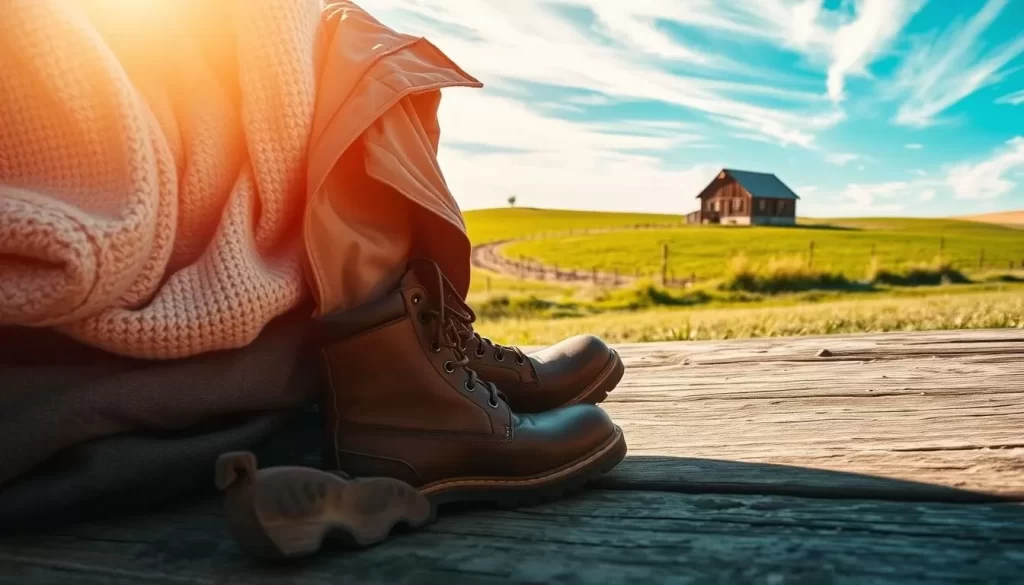
Spring and Fall Essentials
For spring and fall visits, pack layers for unpredictable weather. Include lightweight rain gear and comfortable clothing for outdoor activities. These seasons offer mild temperatures, making them ideal for exploring Kansas.
Summer Must-Haves
Summer in Kansas is hot and humid. Pack lightweight, breathable clothing and sunscreen for protection against the sun. Stay hydrated with a water bottle and manage heat with cooling towels or hats.
Winter Weather Gear
Winter requires warm, insulated clothing. Pack insulated, waterproof boots, gloves, hats, and scarves. January and February are the coldest months, with temperatures in the 30s Fahrenheit. Consider hand and foot warmers for added comfort during outdoor activities.
Weather Monitoring Resources for Travelers
Kansas weather can be unpredictable, making it essential to have the right resources for monitoring weather conditions during your visit. Staying informed about the latest weather forecasts and alerts is crucial for a safe and enjoyable trip.
Reliable Weather Forecasting Tools
To plan your travel itinerary effectively, you need access to reliable weather forecasting tools. Utilize online weather services, such as the National Weather Service, to get accurate and up-to-date information about weather conditions in Kansas.
Understanding Kansas Weather Alerts
It’s vital to understand the different types of weather alerts issued in Kansas, particularly in areas like Kansas City, which is prone to tornadoes. Familiarize yourself with the difference between weather watches and warnings to ensure your safety during severe weather events.
| Alert Type | Description | Action Required |
|---|---|---|
| Weather Watch | Conditions are favorable for severe weather | Stay informed, be prepared |
| Weather Warning | Severe weather is occurring or imminent | Seek shelter immediately |
| Tornado Warning | Tornado is occurring or imminent | Seek shelter in an interior room on the lowest floor |
Special Considerations: Severe Weather Seasons
Understanding the severe weather seasons in Kansas is vital for travelers to ensure a safe and enjoyable journey. Kansas experiences a continental climate with four distinct seasons, each bringing its own set of weather conditions. Spring, in particular, is a time of increasing precipitation, with April and May being among the wettest months.
Tornado Season Awareness
Kansas is located in Tornado Alley, making it one of the states most prone to tornadoes. Tornado season typically peaks in spring, with May being the most active month. It’s essential to stay informed about weather conditions during this time.
Thunderstorm and Flooding Periods
Thunderstorms are common during spring and early summer in Kansas, often bringing heavy rain, lightning, and occasionally hail. These storms can lead to flash flooding, particularly in urban areas and near streams and rivers. Monitoring weather forecasts is crucial during this period to avoid getting caught in severe weather.
| Month | Average Rainfall (inches) | Weather Concerns |
|---|---|---|
| April | 2.5 | Thunderstorms, Heavy Rain |
| May | 4.2 | Tornadoes, Flash Flooding |
| June | 4.5 | Severe Thunderstorms, Heat |
Planning a Seasonal Kansas Itinerary
The ever-changing Kansas weather makes it vital to plan your trip according to the seasons to ensure a memorable experience. To make the most of your visit, it’s essential to understand the state’s climate and plan your activities accordingly.
Matching Activities to Weather Conditions
You should align your activities with the prevailing weather conditions. For instance, outdoor activities like hiking and nature exploration are best during spring and fall when the weather is mild. In contrast, summer is ideal for water activities, while winter is perfect for indoor attractions.
| Season | Weather Conditions | Recommended Activities |
|---|---|---|
| Spring | Mild temperatures, blooming landscapes | Hiking, nature exploration |
| Summer | Hot and humid | Water activities, outdoor recreation |
| Fall | Moderate temperatures, changing foliage | Hiking, scenic drives |
| Winter | Cold, potential snowfall | Indoor attractions, winter sports |
Flexibility Tips for Weather Changes
It’s crucial to build flexibility into your Kansas itinerary. Consider having backup indoor options for days when weather disrupts outdoor plans. You can also benefit from scheduling your most weather-sensitive activities early in your trip, allowing time to reschedule if conditions aren’t favorable.
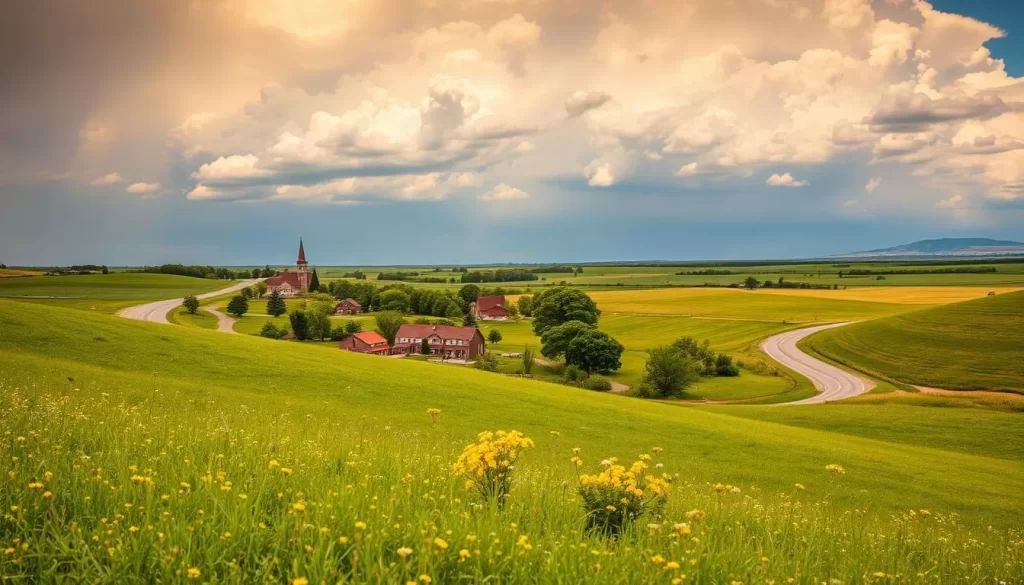
Maintaining a flexible attitude about weather changes will enhance your Kansas experience. Local residents and hospitality staff can provide valuable advice on alternative activities when weather changes affect your original plans.
Conclusion
With its distinct seasons, Kansas offers a unique travel experience that caters to various preferences throughout the year. You’ve gained comprehensive insights into Kansas weather patterns and how they influence travel experiences. The best months for your Kansas visit depend on your personal preferences and desired activities.
Generally, spring (April-May) and fall (September-October) offer the most comfortable weather conditions for a wide range of activities. Understanding regional variations across Kansas helps you tailor your trip planning. With proper planning and flexibility, you’ll discover that Kansas offers rewarding travel experiences, showcasing different aspects of the state’s natural beauty and cultural heritage. There’s something for everyone, regardless of the time of year you visit, ensuring a fun and memorable experience.
The above is subject to change.
Check back often to TRAVEL.COM for the latest travel tips and deals.



